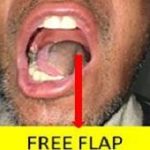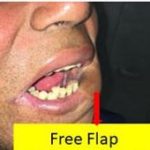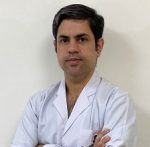HEAD & NECK CANCER TREATMENT
Overview
Head & Neck Cancer services team provides Comprehensive Cancer Care from Prevention to Palliation. We also educate the patient regarding his/ her disease, bust the myths related to its management, and guide him on the path to recovery.
What is Head & Neck Cancer ?
Most head and neck cancers begin in the cells that line the mucosal surfaces in the head and neck area, e.g., mouth, nose, and throat. Mucosal surfaces are moist linings of hollow organs and cavities of the body. Normal mucosal cells look like scales (squamous) under the microscope, so head & neck cancers are often referred to as squamous cell carcinomas. Some head & neck cancers begin in glandular cells and are called adenocarcinomas.
Head & Neck Cancer includes:
Symptoms of Head & Neck Cancer
- Non-Healing Ulcer
- Bleeding
- Lump or swelling in the jaw, face, or mouth
- Loosening of teeth
- Pain, numbness, or weakness on the face
- Difficulty in opening the jaws and chewing
- Difficulty in swallowing
- Change in speech
- Pain in the ear or hearing loss
- Difficulty in breathing
- White or red patches in the mouth
- Loss of weight
- Swelling in the neck
Diagnosis and Investigation Head & Neck Cancer
To find the cause of symptoms, a surgical oncologist evaluates a person’s medical history, performs a physical examination, and orders diagnostic tests. The examination and tests conducted may vary depending on the symptoms. Examination of a sample of tissue under the microscope is always necessary to confirm a diagnosis of cancer.
We insist on clinical examination and believe that a “Hand Scan is better than a CAT Scan”
- Physical examination may include visual inspection of the oral and nasal cavities, neck, throat, and tongue using a small mirror and/or lights. The surgical oncologist may also feel for lumps in the neck, lips, gums, and cheeks.
Myth: Biopsy or FNAC leads to the spreading of cancer.
A biopsy means removal of a small piece of tissue. A pathologist studies the tissue under a microscope to make a diagnosis. A biopsy is the only sure way to tell whether a person has cancer.
- Endoscopy of relevant area wherever indicated.
- Laboratory tests examine samples of blood, urine, or cells from the nodes.
- X-rays create images of areas inside the head and neck on film.
- CT scan is a series of detailed pictures of areas inside the head and neck.
- CT scan is a series of detailed pictures of areas inside the head and neck.
- Magnetic resonance imaging (or MRI).
- PET scan in selected cases.
If the diagnosis of cancer is confirmed, we want to know the stage (or extent) of the disease. Staging is a careful attempt to find out whether cancer has spread and if so, to which parts of the body. Knowing the stage of the disease helps the surgical oncologist plan treatment..

Treatment of Head and Neck Cancer
Various types of head and neck surgeries are
- Composite Resection/ Commando operation for oral cancers
- Maxillectomy
- Different types of Laryngectomies, TEP for voice rehabilitation
- Various approaches for Thyroid surgeries
- Parotidectomy
- Neck dissections
- Skull base surgery, Ear operations for cancer
- Skin lesions of Head & Neck area
- Surgery for Eye cancers
- Plastic Surgery: Reconstruction with Free flaps (Anterolateral Thigh flap, Medial Sural Artery Perforator flap, Radial Artery Forearm flap, Free Fibula flap), various local and regional flaps for reconstruction of face ,neck and oral defects.
Frozen Section
It is a modern technique to ensure the complete removal of cancer during surgery. The main cancer specimen is immediately sent to the laboratory after surgery for assessment by the Frozen section technique. The pathologist quickly freezes the sample from the margins of the specimen in a cryostat and takes a thin slice of the sample from various areas. They freeze the tissue at -15 to -20 degrees centigrade. They then place this under a microscope, analyze the sample, and report within 30 minutes.
Advanced Cancer of cheek excised and reconstruction done with free flap


Cancer of hard palate operated and rehabilitated with obturator



Cancer of tongue operated and reconstructed using free flap

Cancer of lower lip operated and reconstructed using free flap


Cancer of right lower jaw operated and reconstructed using free flap

How is RGCI Different
Tumor Board/ Multispecialty Clinic Evaluation
Each and every Head & Neck cancer patient is evaluated by a special team of Surgical
Oncologists (Head & Neck unit), Medical Oncologists, Radiation Oncologists, Onco-pathologists, and Imaging Specialists. Depending on the age, general condition, type of pathology, and stage of the disease, a custom-made treatment plan is charted out for each and every patient as per International Treatment Guidelines. (NCCN – National Comprehensive Cancer Network).
DO’s after Surgery
- Speak less to ensure proper healing of stitches in the mouth and tongue.
- Liquid diet with adequate salt has to be given at regular intervals of 2 hours.
- Feeding through tube should be given with patient in sitting or 300 head-up position. Each feed of around 300 ml should be given slowly over a period of 20 minutes.
- All medicines as prescribed in the discharge note along with medicines for chronic diseases like diabetes, hypertension, thyroid-related, and asthma should be continued as earlier.
- Oral hygiene with Betadine mouth wash in 1:1 ratio with water to be done alternately with Hydroxyl mouth wash in 1:1 ratio with water every 2 hourly.
- In the case of free flap reconstruction patient should sleep in a straight position and follow instructions of plastic surgeon.
- Walking and moving around is a must.
- If the tracheostomy tube is there you may have to clean the inner cannula frequently preferably every 2-3 hourly.
- Keep the bib wet around the tracheostomy tube.
- Shoulder exercises as and when advised.
- Minimal blood-stained discharge from tracheostomy tube secretions is considered normal, don’t panic.
- Care of the drain and output charting as advised (you can see the video attached for reference).
- Care of the wound as advised.
DON'Ts after Surgery
- Avoid sudden exertion to the head and neck area.
- Avoid room heaters if you have a tracheostomy tube.
-
Avoid addictions.
- Avoid brushing your teeth. Follow instructions of your surgeon regarding diet, mouth care.











